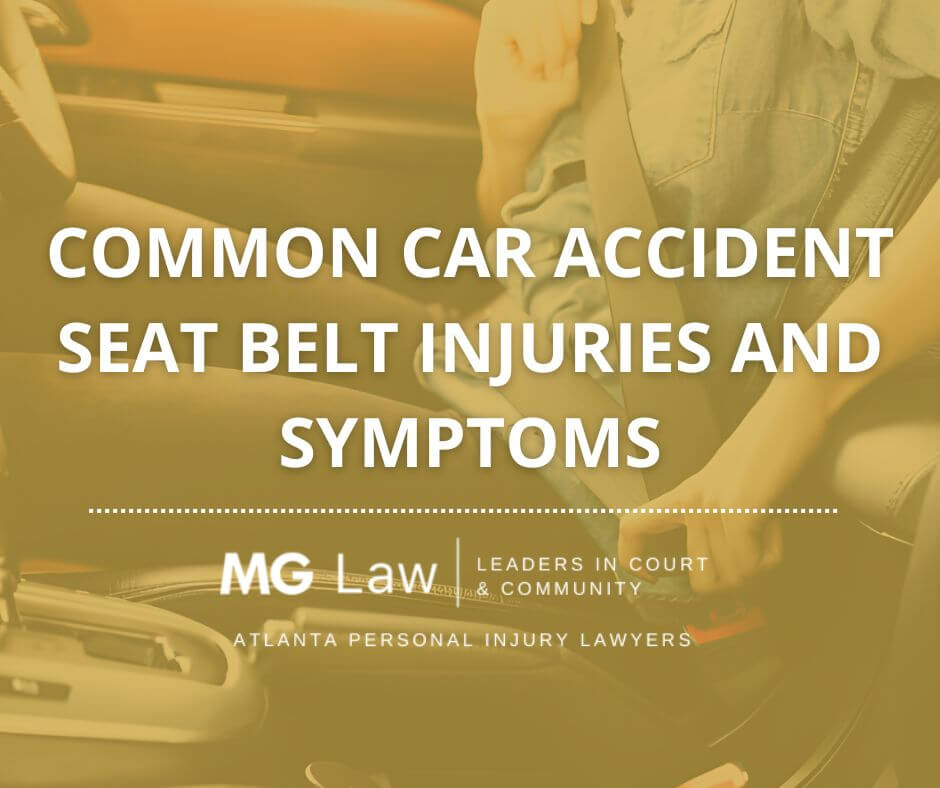
Seat belts prevent thousands of deaths each year and are designed to prevent severe injuries.
However, even when used as intended, seat belts can cause injuries. The crash itself may not injure you but rather the seatbelt. If you believe you suffered a seatbelt injury, consult an attorney to discuss your options.
Seat belts are an active safety system that keeps the belted occupant as motionless as possible in a crash.
When a vehicle hits—or is hit—by something, the change in momentum activates the seat belt’s locking mechanism to restrain the seat occupant. While this is meant to save your life and prevent catastrophic injury, it sometimes results in injuries itself.
Feel free to give our experienced Atlanta accident lawyers a call at (770) 988-5252 or send an online message today for a free consultation.
Types of Car Accident Seat Belt Injuries
Seat belt injuries can be severe and are more likely to occur if there is tremendous velocity and impact involved in a collision.
In a high-speed accident, a seat belt has to compensate for the impact’s force. Precisely, it locks against the body to keep you from going through the windshield, hitting the dashboard, or moving from your seat.
Seat Belt Syndrome
You may have never heard of the term “seat belt syndrome” before. Still, in severe accidents, contact with the seatbelt can result in seat belt syndrome, which refers to internal nerve injuries in your neck, chest, or abdominal cavity.
Common Seat Belt Injuries
There are a handful of injuries we often routinely attribute to the seatbelt, including:
- Cervical injuries. Cervical injuries are some of the most common seat belt injuries because the restriction of the seat belt causes neck and spinal injuries.
- Thoracic injuries. Common chest injuries include broken ribs, fractured sternum, pulmonary contusion (bruise on the lungs), and, in rare instances, a myocardial contusion or bruising of the heart.
- Abdominal injuries and organ damage. One of the most extreme and severe types of injuries from a seatbelt is organ damage. A damaged or ruptured organ can cause a hemorrhage, which often pools in the abdominal cavity and can lead to organ failure and even death.
Although these are just a few examples, there are infinite types of injuries that you can suffer because of a seat belt.
Seat Belt Injury Symptoms
After a motor vehicle accident, it is common to experience bruising and abrasions across your body where the seatbelt lies. This discoloration is called the “seat belt sign” and is often just a sign of superficial injury but can sometimes indicate a more serious internal injury.
Immediately after the impact of a collision, it can be challenging to differentiate your symptoms, injuries, and pain. It can be hard to pinpoint precisely which symptoms correlate to which injuries. However, there are specific symptoms that are commonly associated with seatbelt injuries.
Neck Pain
One of the most common types of seat belt injuries is whiplash. Whiplash happens when your head is forced at a high speed in one direction opposite your neck and body. It causes soft tissue damage in your neck, also known as seat belt whiplash. Whiplash can cause general pain, stiffness, and soreness in your neck. It can lead to a loss of a range of motion, tinnitus, headaches, and chronic pain.
Abdominal and Chest Pain
During impact, the seat belt restraint can cause enormous pressure on your abdomen and chest. Because the seat belt locks in place to prevent your body from propelling forward, the counterforce can cause injury to your chest and abdomen. The most prominent symptom is to feel pain in your chest and overall abdominal area.
Respiratory and Cardiac Issues
You may not immediately think so, but seat belts can cause heart and lung injuries from the pressure exerted during the crash. Breathing may become labored if you have damaged your heart and lungs. You should seek medical attention immediately if you exhibit cardiac or respiratory symptoms.
Weakness and Nerve Damage
Seat belt injuries commonly affect the nerves, especially those in your lower back. If these nerves are injured in a crash, you may likely experience weakness in your back and legs.
Internal Injury Symptoms
Internal injuries can go undiagnosed for days or even weeks. Awareness of potential symptoms of underlying or manifesting injuries is essential.
Other signs that you may be suffering from an internal seat belt injury can include:
- Overall pain or discomfort,
- Feeling sick,
- Bruising,
- Bloating,
- Stomach cramps,
- Abdominal pain,
- Diarrhea or abnormal bowel movements,
- Nausea and vomiting,
- Loss of mobility, and
- Paralysis.
Signs and symptoms can be mild to severe, depending on the type and extent of internal injury.
Contact Our Georgia Auto Accident Attorneys
If you suffered a seat belt injury from a car accident, seeking guidance and advice from an experienced accident attorney is a good idea.
At MG Law, our Avvo-rated attorneys always offer free, initial consultations. Contact us online or call (770) 988-5252 to schedule yours.

